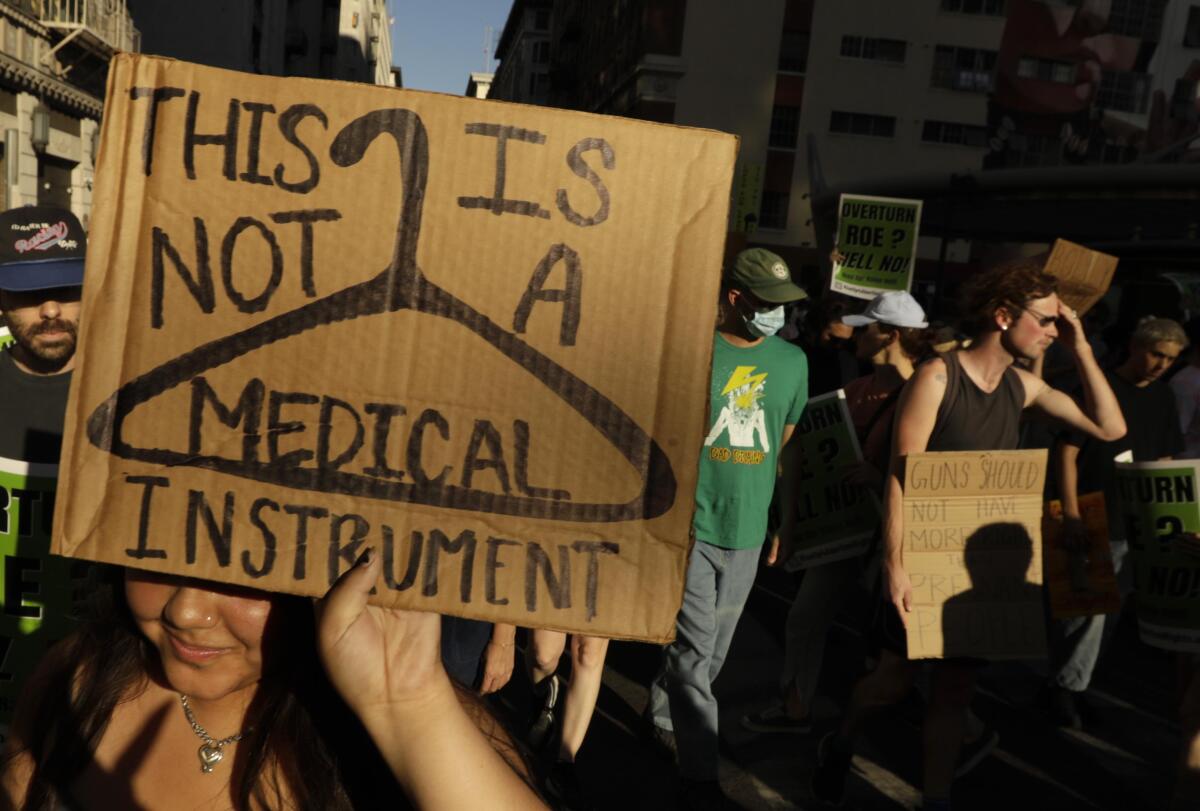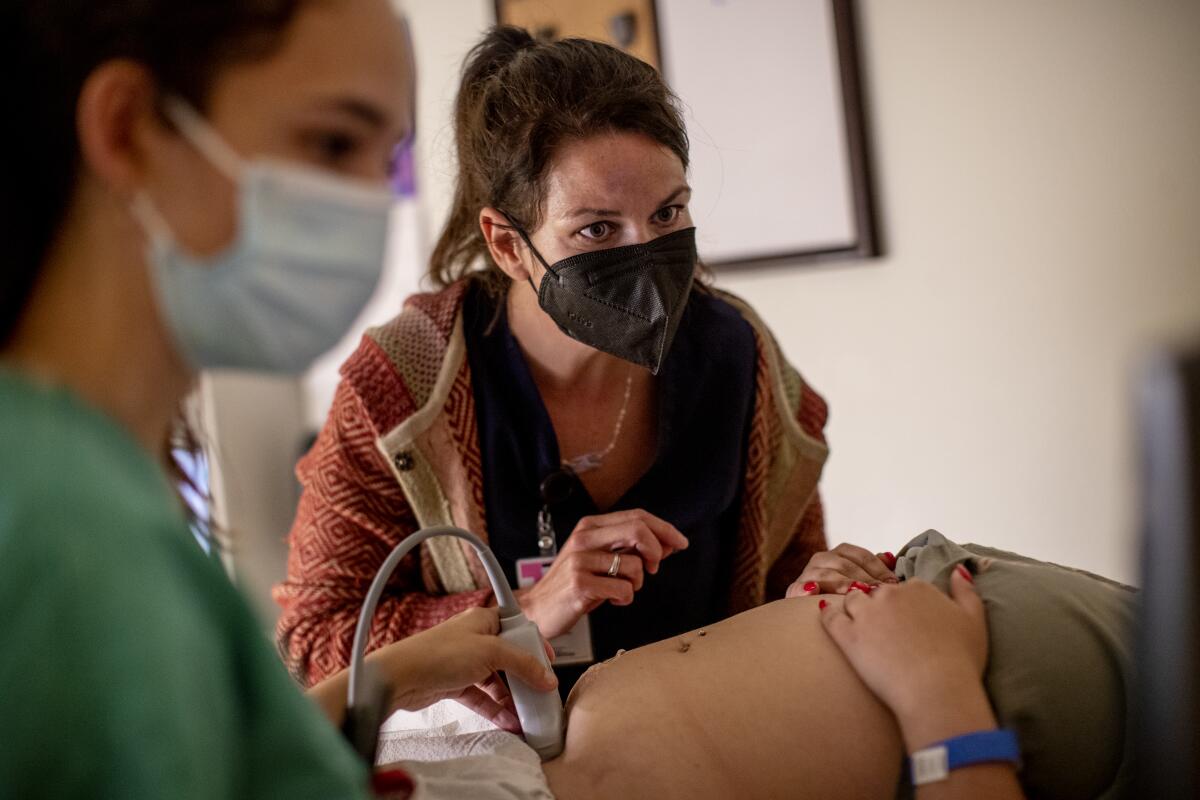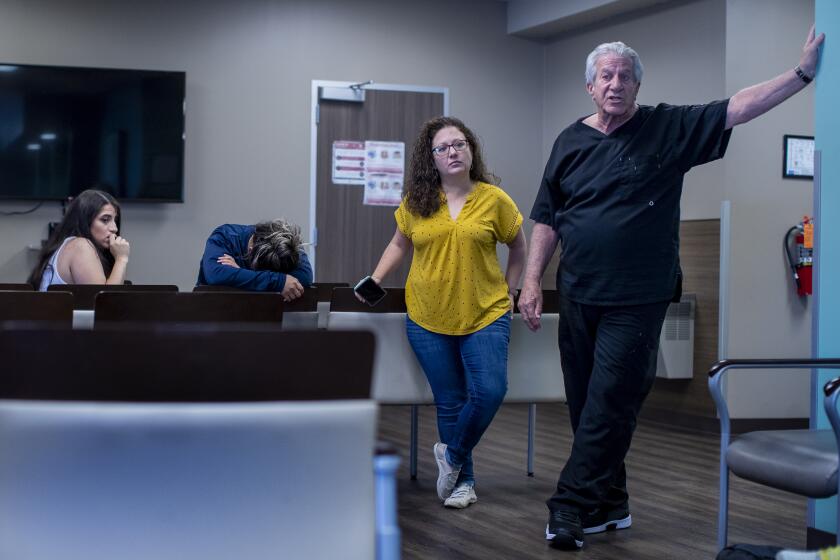Column: In a chaotic post-Roe world, here’s what it will take for women to still get abortions

- Share via
Brittany Fonteno never wanted to imagine the chaos of a post-Roe world.
One of desperate, angry women begging healthcare workers for an abortion — and then leaving clinics distraught with only vague ideas of where to turn next for help.
But after Texas passed what, at the time, seemed like a draconian ban on abortions after about six weeks of pregnancy, the president and CEO of Planned Parenthood Arizona knew she had to imagine it. She had no choice.
“It’s terrible to think that people may be forced to carry pregnancies to term and give birth to pregnancies that were unintended or unwanted,” she said when we first spoke, weeks before the Supreme Court struck down the right to an abortion on Friday. “But we know how this is going to play out. It’s not a guessing game.”
So, a few months ago, Fonteno reached out to her counterpart, Darrah Johnson, at Planned Parenthood of the Pacific Southwest in San Diego. Together, along with the staffs of their affiliates, they hammered out a plan to bring order to the coming chaos.
Arizona, both women knew, would likely make abortion illegal if Roe fell.
The governor is a Republican and Republicans hold a thin majority in the state Legislature. Together, they recently enacted a ban on all abortions after 15 weeks of pregnancy, with no exceptions for rape or incest.
So, rather than abandon the thousands of Arizonans who need reproductive healthcare each year, merely handing them a list of out-of-state clinics to cold call as they tearfully realize they can’t get an abortion, the Planned Parenthood affiliates have adopted a model that’s more like a warm handoff.
An abortion clinic is San Antonio is forced to turn away patients in the waiting room as the Supreme Court overturns Roe vs. Wade.
Like a primary care physician sending you down the hall to get your blood drawn by a specialist and then circling back after the procedure to talk through the results.
That could mean making a referral to schedule an appointment, buying a plane ticket, paying for gas, getting a rental car, securing childcare, booking a hotel room or even paying for the abortion procedure itself.
“It’s all about providing logistical support for patients who need to travel to get the abortion care they need,” Fonteno said.
The intentionality of such an approach will be critical in the coming weeks and months, as millions of women start to sort out the logistics of accessing reproductive healthcare in a post-Roe world.
Some 26 states are expected to ban or severely restrict access to abortion, especially in the South and Midwest. California, led by Gov. Gavin Newsom and top Democrats in the Legislature, has positioned itself as a sanctuary for women seeking the procedure.
And, indeed, a recent report from UCLA’s Center on Reproductive Health, Law and Policy found that between 8,000 and 16,000 more women are expected to travel to California every year for abortions. That includes as many as 9,400 in Los Angeles County alone.
“I want folks to know around the rest of the country, many parts of the globe, that I hope we’re your antidote to your fear, or anxiety, perhaps to the cynicism that many of you are feeling about the fate and future,” Newsom said Friday.
But just saying we’re a sanctuary, even putting money behind it, is nowhere near enough. Especially at time of — as Newsom aptly put it — a “great divergence” between red states and blue states.
It’s about to become extremely difficult for women to know exactly where to go, how to get there and who to trust. Many women might not even know they still have a right to get an abortion, given the onslaught of rhetoric from Republicans trying to criminalize it.
This will be especially true for poor women of color who can’t just jump on a plane or hop in the car and drive hundreds of miles, and might not even have internet access.

“I think we’re going to have to do — and it’s one of the models of care we’re building — a lot more targeted advertising, talking to people in communities about how they can get access to information and who they can call,” Johnson said. “Literally a phone number and literally a website.”
That is a big reason why she wanted to partner with Planned Parenthood Arizona.
“We do see it as our responsibility to step up,” Johnson said. “And this is the way we can step up.”
Of course, stepping up has already become more complicated now that Roe has actually fallen.
On Friday, only hours after the ruling in Dobbs vs. Jackson Women’s Health Organization overturned Roe vs. Wade, Planned Parenthood Arizona announced that it had decided to “pause abortion services because of the complex legal landscape in our state.”
At issue is which statewide restriction on abortion applies now. The ban after 15 weeks of pregnancy that Arizona enacted earlier this year? Or the total ban that was enacted 158 years ago when Arizona was still a territory?
Until state officials come up with an answer — and there’s a good chance the courts will have to do that — Planned Parenthood will have no choice but to turn away women who need abortions at its clinics in and around Phoenix, Flagstaff and Tucson.
And thanks to the legal murkiness over whether even helping women get abortions is still allowed, what had been a plan to share the cost of sending patients to California, has now largely fallen to Planned Parenthood of the Pacific Southwest. For the time being, Fonteno said her affiliate is sticking to referrals.
Thankfully, the California Legislature has stepped up with legislation — Senate Bill 1142, authored by Sen. Nancy Skinner (D-Berkeley) — that would create a fund for private donations to cover abortion services, including those sought by women traveling here from other states. It’s just one in a package of related bills moving swiftly toward Newsom’s desk.
California’s governor clearly embraces his rise as a dominant, resonating voice for Democratic states nationwide
In the coming years, Fonteno expects as many as 6,000 women to leave Arizona annually to get an abortion. In fact, hundreds already do because it’s easier than dealing with the bureaucratic hurdles set up by Republican lawmakers, including waiting periods and listening to a speech designed to dissuade women from going through with the procedure.
Most women, Fonteno predicts, will drive to San Diego, Imperial and Riverside counties, ending up at clinics under Planned Parenthood of the Pacific Southwest.
Consider it the beginning of what very likely will be California’s future. With the unhinged, extreme right tendencies of this Supreme Court, this almost surely won’t be the last time our state will have to step up as a blue bulwark.
In a concurring opinion in Dobbs vs. Jackson Women’s Health Organization, Justice Clarence Thomas wrote that the court should reconsider past rulings legalizing same-sex marriage and even contraceptives.
In their dissent, Justices Elena Kagan, Stephen G. Breyer and Sonia Sotomayor wrote that “no one should be confident that this majority is done with its work.”
In other words, don’t get used to your rights. That is, unless, you live in California.
More than just a sanctuary for those seeking abortion, we one day soon will become a sanctuary for those seeking democracy, I suspect.
“Luckily, in California, we have political champions who are willing to be brave and do the right thing,” Johnson said. “But so many other states are completely not in that circumstance.”
More to Read
Sign up for Essential California
The most important California stories and recommendations in your inbox every morning.
You may occasionally receive promotional content from the Los Angeles Times.













